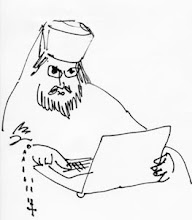 The third part of Fr Placide’s study The Orthodox Church and the Philokalia is entitled “The Influence of Philocalic Spirituality,” and is divided into four parts: “Philocalic Spirituality in Greece,” "The Paisyan Renewal in Russia,” “The Hesychast Tradition in Romania,” and “The Philokalia and the West.” Most of what’s covered in this section should already be familiar to any reader who has an acquintance with the literature. My only point of criticism is Fr Placide’s claim that both St Seraphim of Sarov and St Herman of Alaska had copies of The Philokalia. That claim meets with my sternest skepticism. I also have to disagree with this comment of Fr Placide, concerning Fr Dumitru Staniloae: “He is unquestionably the first contemporary theologian to rediscover the essential place of St Gregory Palamas’ thought in the theological and spiritual tradition of Orthodoxy.” If we are to take the adjective “contemporary” literally, then I would agree – Fr Dumitru wrote about Palamas before Fr John Meyendorf, Archbishop Basil (Krivocheine), and Vladimir Lossky. But if we take it to mean “modern,” that Fr Placide is mistaken. Sympathetic interest in the life and thought of Palamas in Russia goes back at least to 1860, in the pioneering work of Igumen Modest (Strel’bitskii), later Archbishop of Volynsk and Zhitomir. His book, originally written as a Master’s thesis and published in 1860, initiated a period of serious interest in the Hesychast controversies among Russian patrologists and Byzantinists – though not, notably, among dogmatic theologians – that would last until the Revolution of 1917.
The third part of Fr Placide’s study The Orthodox Church and the Philokalia is entitled “The Influence of Philocalic Spirituality,” and is divided into four parts: “Philocalic Spirituality in Greece,” "The Paisyan Renewal in Russia,” “The Hesychast Tradition in Romania,” and “The Philokalia and the West.” Most of what’s covered in this section should already be familiar to any reader who has an acquintance with the literature. My only point of criticism is Fr Placide’s claim that both St Seraphim of Sarov and St Herman of Alaska had copies of The Philokalia. That claim meets with my sternest skepticism. I also have to disagree with this comment of Fr Placide, concerning Fr Dumitru Staniloae: “He is unquestionably the first contemporary theologian to rediscover the essential place of St Gregory Palamas’ thought in the theological and spiritual tradition of Orthodoxy.” If we are to take the adjective “contemporary” literally, then I would agree – Fr Dumitru wrote about Palamas before Fr John Meyendorf, Archbishop Basil (Krivocheine), and Vladimir Lossky. But if we take it to mean “modern,” that Fr Placide is mistaken. Sympathetic interest in the life and thought of Palamas in Russia goes back at least to 1860, in the pioneering work of Igumen Modest (Strel’bitskii), later Archbishop of Volynsk and Zhitomir. His book, originally written as a Master’s thesis and published in 1860, initiated a period of serious interest in the Hesychast controversies among Russian patrologists and Byzantinists – though not, notably, among dogmatic theologians – that would last until the Revolution of 1917.Fr Placide’s chapter on “The Philokalia and the West” was of particular interest to me, since I’m completely ignorant of Western mysticism. The author shows a number of points of astonishing convergence, but ultimately the divergences way heavier. After a sympathetic treatment of John of the Cross (whom he calls “the most representative mystical author of Roman Catholicism” and his idea of the “dark night of the soul,” Fr Placide writes:
A notable difference exists between the experience lived by John of the Cross (and many spiritual people of the West) and that of the Orthodox contemplatives, for whom the experience of God is nothing but light and warmth. The experience of the “passive night of the spirit” is undoubtedly the result of an authentic experience of God, in which human psychology is shaped during the first stages of the spiritual life by a practice of discursive meditation, using reasoning and sensibility in the very depths of faith. Between the attentive vocal prayer recommended to beginners in Orthodox and Western meditation, there exists a gap analogous to the one that separates the icon from religious art found in the Carmels of Spain at the time of the Teresian reform. A similar difference cannot remain without effect on the spiritual experience.All in all, Fr Placide’s book receives my highest recommendation to all readers.









3 comments:
Certainly the interest in the works of St. Gregory Palamas is quite old.
In 1832 the Metropolitan of Ungrovlachia Gregory translated the treatise of St. Gregory "Logoi apodeiktikoi duo peri ekporeuseoos tou Hagiou pneumatos" in Romanian (in Romanian it sounds "Doua cuvinte doveditoare despre purcederea Sfantului Duh).
Very interesting. I'll have to make a note of that.
It is worth mentioning that Gheorghe Miculescu (the future Metropolitan Grigorie) was tonsured and ordained a deacon at the Neamt Monastery by St. Paisy Velichkovski, who assigned him, along with his starets Gherontie, to the translation of the Holy Fathers from Greek into Romanian. Therefore his translations can be counted in the great "philokalic" movement, initiated by St. Nicodeme and continued by St. Paisy and his disciples for Russia and Romanian lands.
Post a Comment